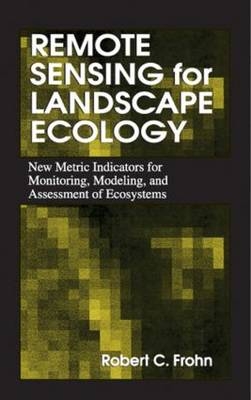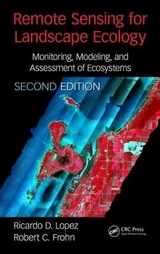
Remote Sensing for Landscape Ecology
Lewis Publishers,U.S. (Verlag)
978-1-56670-275-1 (ISBN)
- Titel erscheint in neuer Auflage
- Artikel merken
Landscape ecology is a rapidly growing science of quantifying the ways in which ecosystems interact - of establishing a link between activities in one region and repercussions in another region. Remote sensing is a fast, inexpensive tool for conducting the landscape inventories that are essential to this branch of science. However, anyone who has conducted studies in the field has already found that traditional landscape ecology metrics are not always reliable with remote images. Landscape Ecology: New Metric Indicators for Monitoring, Modeling, and Assessment of Ecosystems with Remote Sensing presents a new set of metrics that allows remotely sensed data to be used effectively in landscape ecology.
This groundbreaking new work is the first to present new metrics for remote sensing of landscapes and demonstrate how they can be used to yield more accurate analyses for GIS studies. The new metrics expand the capabilities of GIS, reduce interference and incorrect readings, help ecologists better understand ecosystem relationships, and reduce study costs. This set of metrics should be adopted by the EPA and will be the standard measure for future landscape analysis.
This authoritative guide assesses the current state of the field and how remote sensing and landscape metrics have been used to date. It also explains how some of the traditional metrics were developed and how they can fail in landscape studies. Once this background has been established, the new metrics are introduced and their benefits and uses explained. The information in this book has previously been available only in scattered journal articles; this is the first single source for complete background information and instructions on using the new metrics.
Introduction
Goals and Objectives
Significance of Research
Selection of Study Sites
Summary of Chapters
Background and Evaluation of Landscape Metrics
Landscape Ecology Metrics
The Contagion Metric
The Fractal Dimension Metric
Introduction of Improved Metrics
Potential Problems of Existing Landscape Metrics for Use with Remote Sensing Data
Systematic Evaluation of Landscape Metrics
Problems with Contagion
Problems with Fractal Dimension
Research Methods
Overview of Experimental Design
Capability of Metrics to Capture Changes in Landscape Pattern
Sensitivity of Metrics to Spatial Resolution of Remote Sensing Data
Analysis of Metrics Along a Spatial Gradient in Rhodonia, Brazil
Analysis of Metrics Along a Spatial Gradient in Washington, D.C.
Analysis of Metrics Along a Vertical Gradient in the Sierra Nevada
Analysis of Metrics Along a Temporal Gradient in Ouro Preto, Brazil
Empirical Analysis of Landscape Metrics
Metric Capability in Quantifying Changes Along a Spatial Gradient in Rodonia, Brazil
Sensitivity of Metrics to Landscape Pattern Variation
Sensitivity of Metrics to Spatial Resolution
Test of the Regression Equations for PPU and SqP Using Landsat MSS 79 Meter Data
Metric Capability in Quantifying Changes Along a Spatial Gradient in Washington, D.C.
Sensitivity of Metrics to Landscape Pattern Variation
Sensitivity of Metrics to Spatial Resolution
Metric Capability in Quantifying Changes Along a Vertical Gradient in the Sierra Nevada
Sensitivity of Metrics to Landscape Pattern Variation
Sensitivity of Metrics to Spatial Resolution
Metric Capability in Quantifying Changes Along a Temporal Gradient in Ouro Preto, Brazil
Sensitivity of Metrics to Landscape Pattern Variation
Sensitivity of Metrics to Spatial Resolution
Summary Conclusions and Future Work
Bibliography
Index
| Erscheint lt. Verlag | 29.12.1997 |
|---|---|
| Zusatzinfo | 12 equations; 4 Tables, black and white |
| Verlagsort | London |
| Sprache | englisch |
| Maße | 156 x 234 mm |
| Gewicht | 318 g |
| Einbandart | gebunden |
| Themenwelt | Naturwissenschaften ► Biologie ► Ökologie / Naturschutz |
| Naturwissenschaften ► Geowissenschaften ► Geografie / Kartografie | |
| Naturwissenschaften ► Geowissenschaften ► Geologie | |
| ISBN-10 | 1-56670-275-5 / 1566702755 |
| ISBN-13 | 978-1-56670-275-1 / 9781566702751 |
| Zustand | Neuware |
| Haben Sie eine Frage zum Produkt? |
aus dem Bereich



